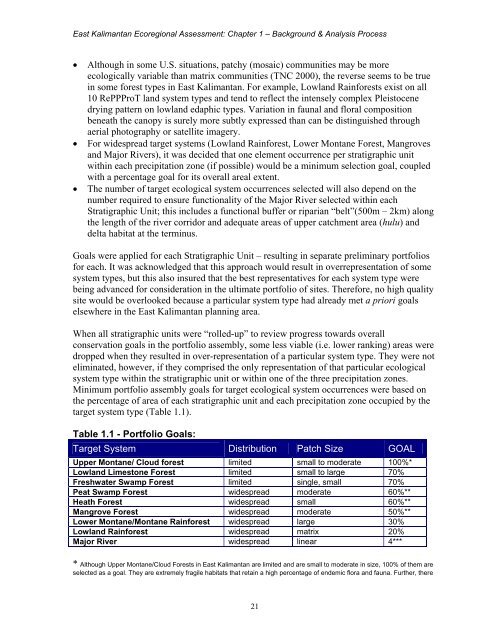Ecoregional Assessment of Biological Diversity in East Kalimantan
Ecoregional Assessment of Biological Diversity in East Kalimantan
Ecoregional Assessment of Biological Diversity in East Kalimantan
Create successful ePaper yourself
Turn your PDF publications into a flip-book with our unique Google optimized e-Paper software.
<strong>East</strong> <strong>Kalimantan</strong> <strong>Ecoregional</strong> <strong>Assessment</strong>: Chapter 1 – Background & Analysis Process<br />
• Although <strong>in</strong> some U.S. situations, patchy (mosaic) communities may be more<br />
ecologically variable than matrix communities (TNC 2000), the reverse seems to be true<br />
<strong>in</strong> some forest types <strong>in</strong> <strong>East</strong> <strong>Kalimantan</strong>. For example, Lowland Ra<strong>in</strong>forests exist on all<br />
10 RePPProT land system types and tend to reflect the <strong>in</strong>tensely complex Pleistocene<br />
dry<strong>in</strong>g pattern on lowland edaphic types. Variation <strong>in</strong> faunal and floral composition<br />
beneath the canopy is surely more subtly expressed than can be dist<strong>in</strong>guished through<br />
aerial photography or satellite imagery.<br />
• For widespread target systems (Lowland Ra<strong>in</strong>forest, Lower Montane Forest, Mangroves<br />
and Major Rivers), it was decided that one element occurrence per stratigraphic unit<br />
with<strong>in</strong> each precipitation zone (if possible) would be a m<strong>in</strong>imum selection goal, coupled<br />
with a percentage goal for its overall areal extent.<br />
• The number <strong>of</strong> target ecological system occurrences selected will also depend on the<br />
number required to ensure functionality <strong>of</strong> the Major River selected with<strong>in</strong> each<br />
Stratigraphic Unit; this <strong>in</strong>cludes a functional buffer or riparian “belt”(500m – 2km) along<br />
the length <strong>of</strong> the river corridor and adequate areas <strong>of</strong> upper catchment area (hulu) and<br />
delta habitat at the term<strong>in</strong>us.<br />
Goals were applied for each Stratigraphic Unit – result<strong>in</strong>g <strong>in</strong> separate prelim<strong>in</strong>ary portfolios<br />
for each. It was acknowledged that this approach would result <strong>in</strong> overrepresentation <strong>of</strong> some<br />
system types, but this also <strong>in</strong>sured that the best representatives for each system type were<br />
be<strong>in</strong>g advanced for consideration <strong>in</strong> the ultimate portfolio <strong>of</strong> sites. Therefore, no high quality<br />
site would be overlooked because a particular system type had already met a priori goals<br />
elsewhere <strong>in</strong> the <strong>East</strong> <strong>Kalimantan</strong> plann<strong>in</strong>g area.<br />
When all stratigraphic units were “rolled-up” to review progress towards overall<br />
conservation goals <strong>in</strong> the portfolio assembly, some less viable (i.e. lower rank<strong>in</strong>g) areas were<br />
dropped when they resulted <strong>in</strong> over-representation <strong>of</strong> a particular system type. They were not<br />
elim<strong>in</strong>ated, however, if they comprised the only representation <strong>of</strong> that particular ecological<br />
system type with<strong>in</strong> the stratigraphic unit or with<strong>in</strong> one <strong>of</strong> the three precipitation zones.<br />
M<strong>in</strong>imum portfolio assembly goals for target ecological system occurrences were based on<br />
the percentage <strong>of</strong> area <strong>of</strong> each stratigraphic unit and each precipitation zone occupied by the<br />
target system type (Table 1.1).<br />
Table 1.1 - Portfolio Goals:<br />
Target System Distribution Patch Size GOAL<br />
Upper Montane/ Cloud forest limited small to moderate 100%*<br />
Lowland Limestone Forest limited small to large 70%<br />
Freshwater Swamp Forest limited s<strong>in</strong>gle, small 70%<br />
Peat Swamp Forest widespread moderate 60%**<br />
Heath Forest widespread small 60%**<br />
Mangrove Forest widespread moderate 50%**<br />
Lower Montane/Montane Ra<strong>in</strong>forest widespread large 30%<br />
Lowland Ra<strong>in</strong>forest widespread matrix 20%<br />
Major River widespread l<strong>in</strong>ear 4***<br />
* Although Upper Montane/Cloud Forests <strong>in</strong> <strong>East</strong> <strong>Kalimantan</strong> are limited and are small to moderate <strong>in</strong> size, 100% <strong>of</strong> them are<br />
selected as a goal. They are extremely fragile habitats that reta<strong>in</strong> a high percentage <strong>of</strong> endemic flora and fauna. Further, there<br />
21

















